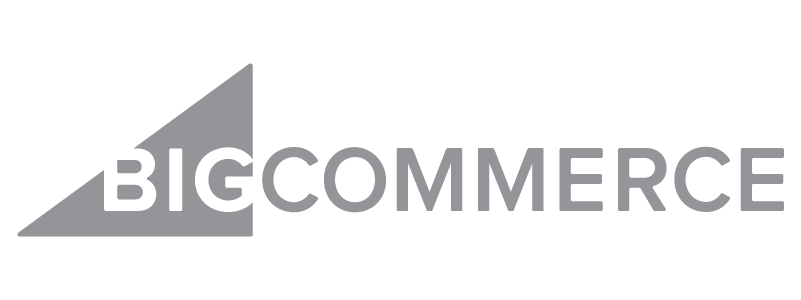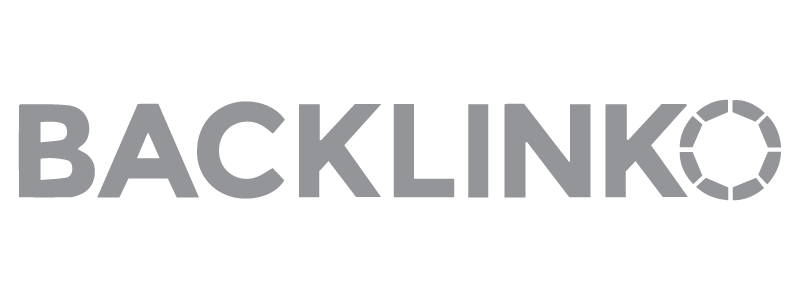The ecommerce industry has been growing rapidly since the pandemic in 2020, and its growth isn’t slowing down any time soon. Global retail ecommerce sales are projected to see a 385% increase in growth from 2014 to 2023.
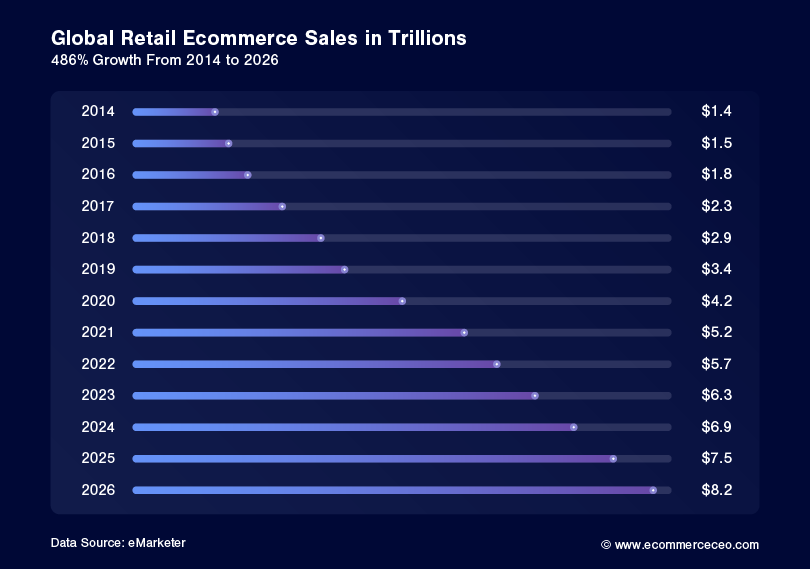
With more and more people shopping online and social media platforms integrating more shopping features, now is a great time to start your own online business.
If you love fashion, design, and accessories, then an online boutique might be a great fit for you. But starting an ecommerce business isn’t as simple as just setting up shop and picking your favorite clothes.
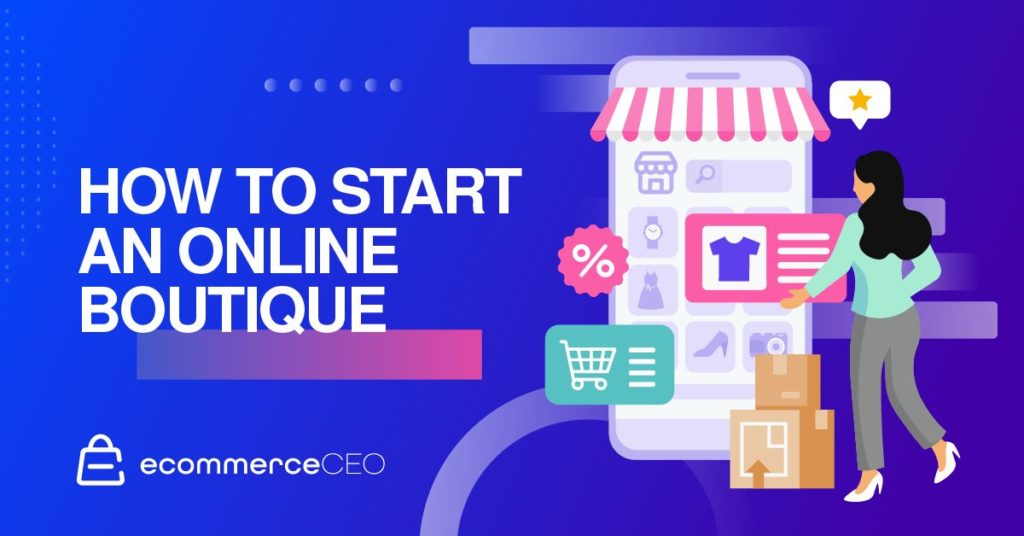
In this guide, we’ll talk about how online boutiques can be profitable, how to start an online boutique from home, and ways you can attract customers from day one. This will help you set up a successful online boutique.
Step By Step Guide To Starting an Online Boutique
If you’re passionate about a specific branch of the fashion industry, then an online boutique can be a profitable endeavor for entrepreneurs.
What is an Online Boutique?
An online boutique is a bit different from any other clothing store. Boutiques are a bit more unique, modern, and niched down compared to standard ecommerce businesses.
Boutiques often offer a very specialized style that draws in extremely loyal customers who aim for that same aesthetic your clothing boutique offers. An online boutique is considered trendy with high-quality products, and that trendiness can come with a higher price tag.
Think of designer fashion, items that are unique to someone’s culture, custom handbags, or a specific type of jewelry. Clothing or accessories like this would most likely be found in an online boutique.
For instance, take Hazel And Olive. Hazel and Olive is an online boutique specializing in trending women’s fashion. Their online clothing business launched to fame on social media.
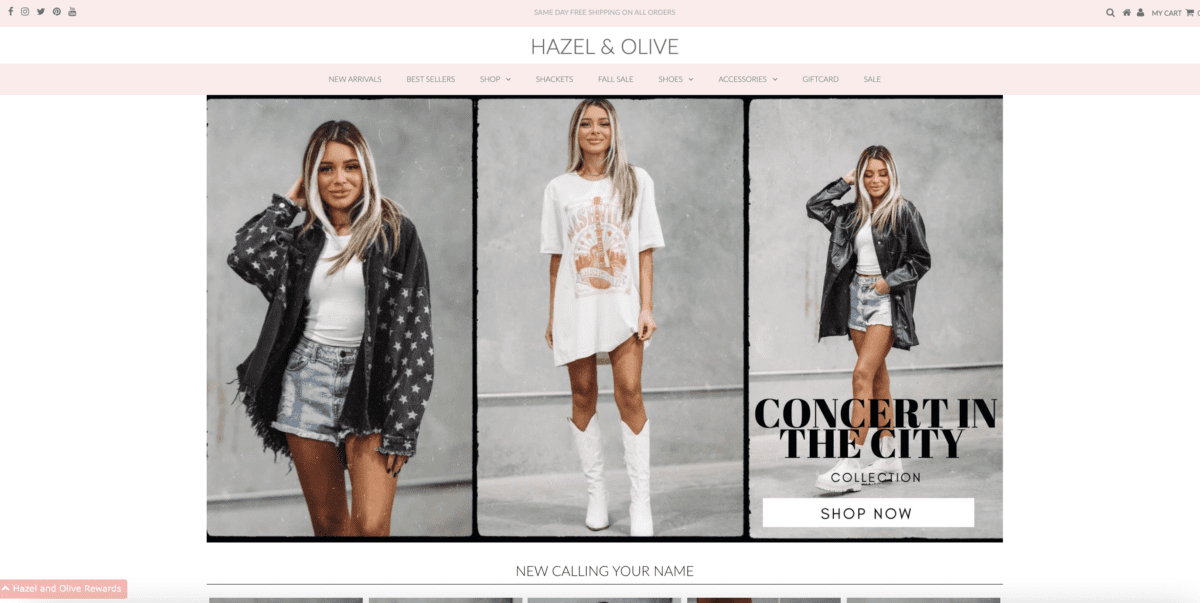
Why You Should Start an Online Boutique
Starting an ecommerce business, especially an online boutique, is ideal for people looking to save on costs. Running and operating a boutique with a retail location can be much more costly than running an online boutique from home.
At a retail location, you constantly have to have enough inventory in stock and also pay for the space. When you have an online store, you eliminate the overhead of a physical location, plus there are options if you don’t have the budget or space to constantly be fully stocked.
An online boutique doesn’t just limit you to one geographical location, either. This opens up your customer base to people around the country (or even the world if you’re planning on shipping internationally).
Are Online Boutiques Profitable?
If you market yourself right, then you can absolutely be profitable with an online boutique.
According to Statista, e-retail sales accounted for 30 percent of retail ecommerce sales in the United States in 2019 – and it’s only projected to keep growing.
Ecommerce retail sales totaled $102.5 billion in the US, and it’s projected to increase to $153.6 billion by 2024.
These numbers include clothing, footwear, purses and bags, and other accessories. Plus, that’s including the surge of online shopping that’s come with the COVID-19 pandemic.
This means you can be extremely profitable if you play your cards right with your online boutique.
If you can identify and break up your costs, then you’re in a good position to identify your true costs of production for profitability analysis. If trying to figure out the math stresses you out, break-even calculators can help you determine your net profits.
Understanding The Legal Requirements Before You Begin
Running an online boutique from the comfort of your home can be an exciting venture. However, beyond creativity and passion, understanding and staying compliant with the important legal requirements is the most important thing. It’s all about doing business the right way to avoid drawbacks that could hinder your progress and success.
Business Registration:
Starting with registration, you need to make your business officially recognized by the law. Depending on the nature of your online boutique, you may want to register as a sole proprietorship, a partnership, an LLC, or a corporation. Ensure you’re conversant with the legal implications of whichever structure you choose.
- Sole Proprietorship: Implies personal liability to all assets and debts.
- Partnership: Shared liability and decision-making abilities.
- LLC: Provides liability protection for the owner(s).
- Corporation: A legal entity that is separate and distinct from its owners.
Applicable Licenses and Permits:
Depending on your local regulations, obtaining certain licenses and permits might be required. Since your business is an online boutique, your physical presence is minimal or non-existence. Nonetheless, a sales tax license or home business permit would be critical. Always check with local authorities or legal experts to ensure you are not missing out on any necessary permits.
Tax Obligations:
The success of your online boutique largely hinges on understanding your tax obligations. Whether it’s sales tax, income tax, or payroll tax, you need to be clear about what applies to you. It’s advisable to consult with a tax expert or accountant early on to guide you in filing accurate and timely returns.
How to Start an Online Boutique
There is so much more to starting an online store than just having a business idea, creating your ecommerce website, and listing your products for sale. You want to make sure that your online boutique is set up for success so you can actually make sales, potentially as soon as day one. If you follow these steps, you’ll be in a great place come launch date.
Step 1: Determine What & How You Want to Sell
The first thing you have to figure out when starting your own online boutique is what you want to sell. The key to a successful online boutique business is selling something that is both profitable and something you are passionate about. What sets an online boutique apart from any other online store is the fact that they serve a specific niche.
If you don’t know what to sell, look into what is trending on Amazon in your niche. That can help guide you in the direction you want to go when you start business planning. Just keep in mind that trends are constantly evolving, so you’ll need your boutique to keep up accordingly.
Once you know what you want to sell, you’ll have to determine how you want to sell. You have a few options to choose from as a new business. Pick the best one based on your business plan.
- With drop shipping, you sell products on your website but don’t house any of the products. Fulfillment centers will produce and ship the products to your customers.
- There are two approaches to wholesale. Firstly, you can purchase products from the manufacturers at wholesale price (when you buy in bulk), store them in a warehouse, and then resell the items. Secondly, a wholesale supplier is a business that sells products they purchase from small business owners.
- Print-on-demand is similar to dropshipping, but your products are more customized. With this type of business, you can design your products on sites like Printful. Suppliers handle all your inventory, storage, fulfillment, and shipping. The suppliers also handle the printing and production of your print-on-demand products.
- Handcrafting is when you’re making everything by hand. Most products on Etsy are handcrafted, for example, and are typically more expensive to factor in your labor costs.
Private label manufacturing is when you receive your products from another source. A manufacturer will sell its products to distributors and wholesalers. You can use manufacturers to supply your online store, but you’ll handle the selling and shipping of your products. Ecommerce software like ShipBob can help you with fulfillment in this instance.
Step 2: Build Your Boutique’s Brand
No matter what site you’re setting yourself up on, having solid branding is key to launching for any business owner. Your boutique’s branding will be how your potential customers can recognize and remember you.
This can be tricky. After all, there’s a lot of competition, so it may take some time to come up with the perfect name or color scheme for your own brand.
You may end up updating your branding as your shop grows, and that’s okay! Just make sure you keep everything consistent on your website, social media profiles, and any printed materials where your branding may appear.
Name Your Boutique
You want your boutique’s brand identity to have a catchy, easy-to-remember, and descriptive name. Also, consider making sure your name isn’t too long so it’s easier for people to find. If you’re struggling to come up with a name for your online shop, consider these points to spark some inspiration:
- Describe what you are selling
- Include your name or someone close to you’s name
- Use alliterations for a catchy name
Don’t forget to make sure your desired business name isn’t already taken!
Design Your Boutique’s Logo & Brand Guide
Your visual identity is your first impression for people finding your online store. Your visual identity includes:
- Your clothing business’ name
- Your business’ logo
- Color palette
- Fonts
- Cover photo for social media
- Company bio and boilerplate
- The brand voice that you use in copywriting and social media captions
You can include all of this information in a brand guide or brand kit to keep everything organized. This way, as you build out your site and graphics, you have something to refer to.
Tools like Canva and Mojomox are great for small business owners who don’t have graphic design abilities. They offer templates to build logos, graphics, and brand kits.
Sign Up For Social Media Platforms
Once you have your boutique’s name, logo, and brand guide set up, you can sign up for social media platforms. Social media marketing gives you the chance to connect one-on-one with your audience, which is especially critical when you’re operating solely online.
As an online boutique, you’ll definitely want a presence on Facebook and Instagram, where shopping features are built into the platform, and on TikTok, where small businesses can connect with people through viral videos.
Make sure your branding on social media is consistent with your ecommerce website. This will help you establish a visual identity that your loyal fans and customers can easily remember.
Plus, keeping your information – like your name, address, and phone number – consistent across the web can help boost your SEO with search engines.
Identify Your Target Customers & Their Pain Points
If you still haven’t determined what exactly you want to sell, this can really help you narrow it in and niche down.
Identifying your target market will help you properly reach your ideal customer. Doing this can help you increase conversions by making sure you’re creating the right content for your audience and better understanding your audience’s needs.
For example, if your target audience is new moms, you’ll want to identify their specific needs. What clothing options might new moms be looking for that aren’t readily available on the market?
A boutique that did this well is Hoya Evening Butterfly. This small shop sells handmade Korean-inspired and themed accessories, including hanboks, on Etsy. She started her own boutique after being frustrated at the lack of Korean fashion options in the United States. She saw a pain point that her fellow Koreans in the US might be facing and was thus able to identify her target audience and create a solid business plan.
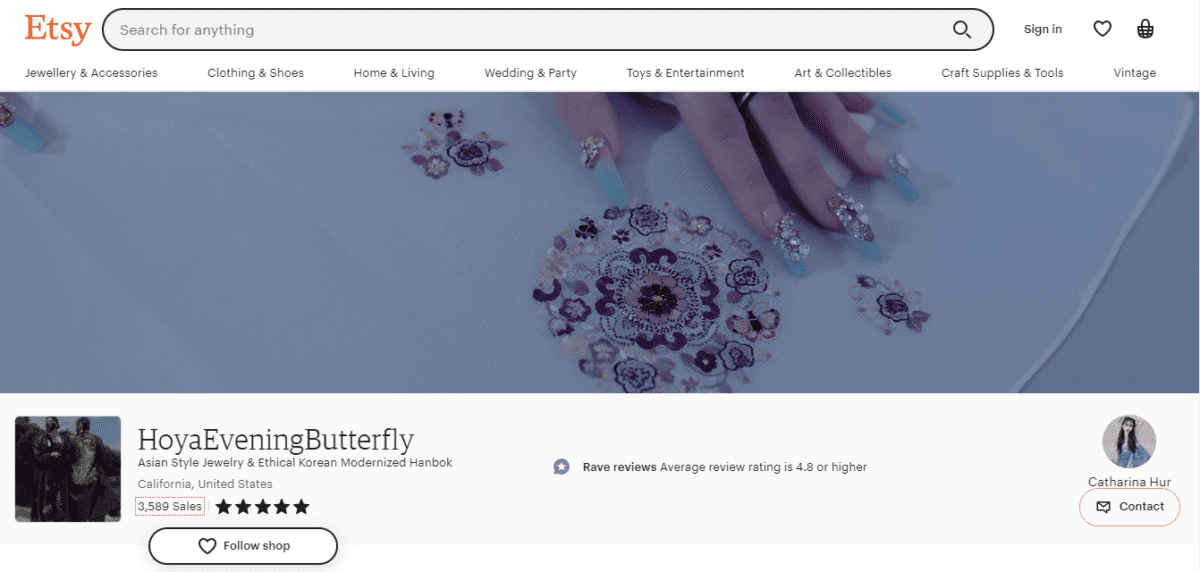
Step 3: Decide Which Ecommerce Platform You’ll Use
Once you know what you’re selling and have your branding set up, it’s time to set up your site and your online boutique store.
There are lots of ecommerce platforms at your disposal. It will depend on what you think is best for your business and what business tools you need built into the platform.
Sites like Shopify and Bigcommerce are extremely popular and for good reason.
Shopify is a great place to get set up if you’re setting up your online boutique and plan on dropshipping. Shopify also integrates with most sites, so it’s easy to add to your website builder.
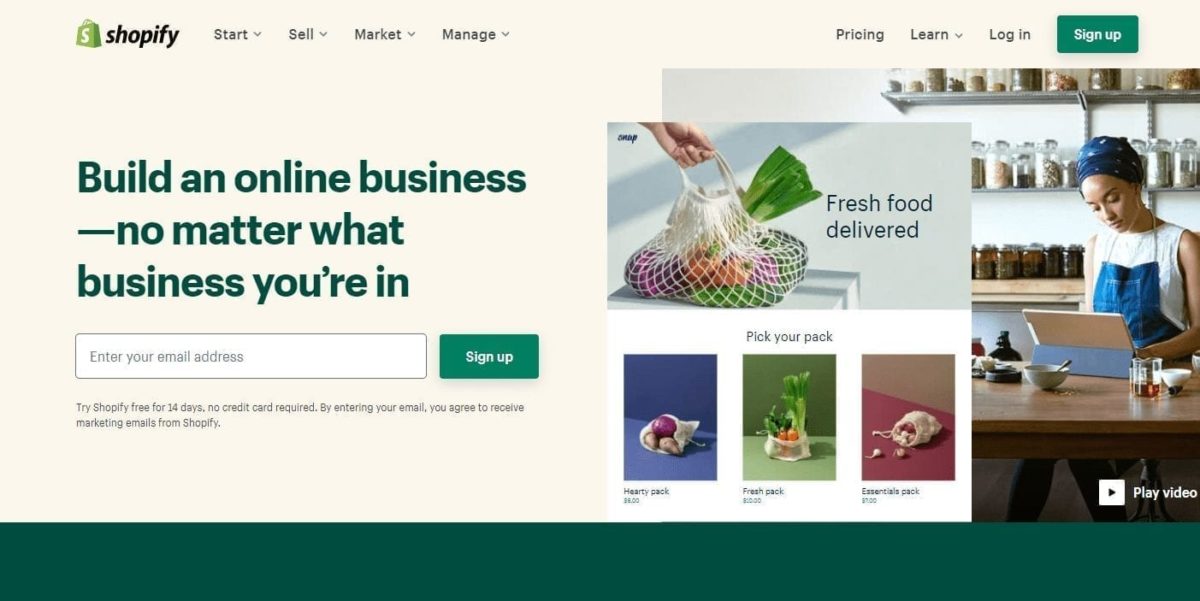
If you’re planning on having tons of products, though, you may want to consider BigCommerce. They’re known for being able to handle an extremely high volume of SKUs.
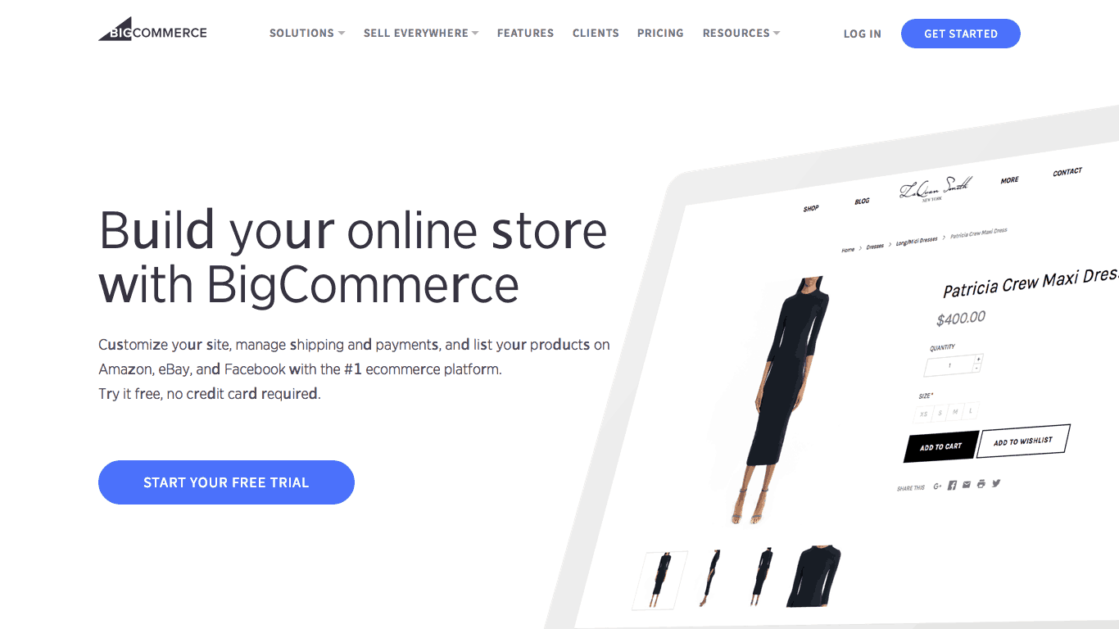
Etsy is also popular for new boutiques that are handcrafting thanks to brand recognition and trust associated with Etsy. The main downside is that there are lots of processing and transaction fees.
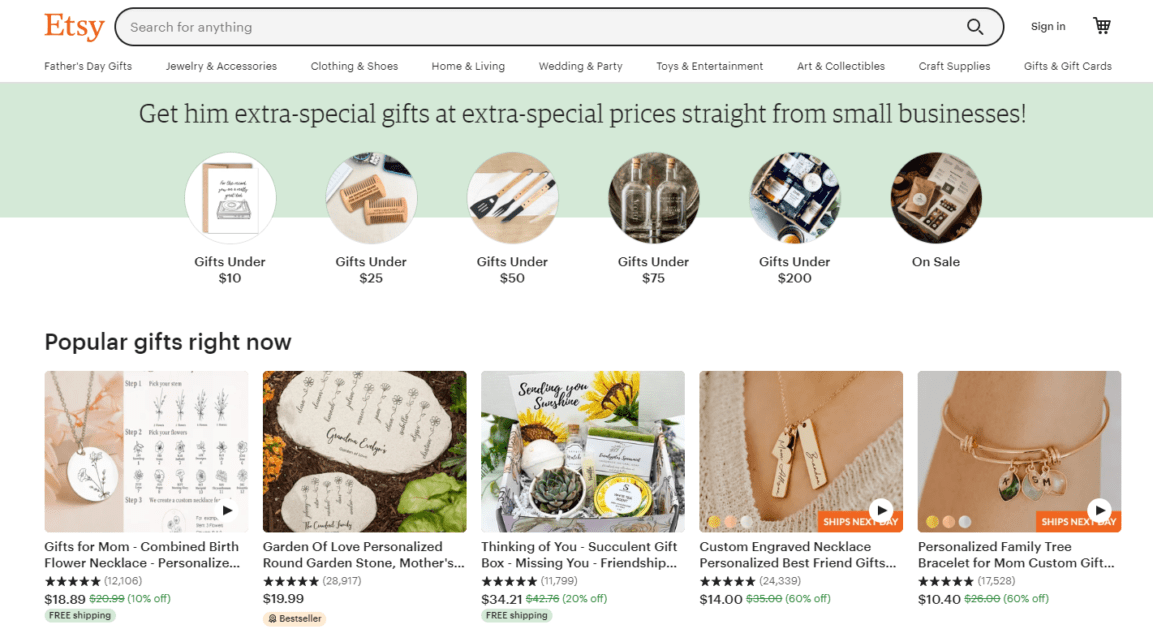
Step 4: Obtain Your Sales Tax Permits
Just because you are selling online doesn’t mean you don’t need a business license. You’ll need an EIN, a sales tax permit, and a business license to sell online.
An Employer Identification Number (aka EIN) will help you protect your social security number as you work with the IRS. You’ll want to ask your accountant if setting your business up as a limited liability company (LLC) or S Corp is right for you.
You’ll also need an EIN if you want to set up a business bank account. You’ll want to keep your business finances separate. Having your federal tax ID number and everything set up with the IRS will save you a big headache later.
The exact type of paperwork you need will depend on your state or country. It will also vary depending on exactly what your business entity is selling. The last thing you want is to be hit with a heavy fine because you didn’t have the right paperwork lined up. After all, we all have to pay sales tax!
Step 5: Budget for Your Launch
Starting your own business isn’t free. You want to make sure you properly budget for your launch so you can be prepared once orders start coming in.
There are a lot of factors to consider when budgeting for launch. A lot of people make the mistake of just factoring in the costs of products.
But you also have to factor in shipping costs, any software you’re using, web hosting fees, and your time. Plus, marketing should also be included in your budget so you can promote your products. Without promotion, your site may just be a sitting duck.
If you need help to secure funding, personal loans are an option for those with a decent credit score. Personal loans mean you won’t have to worry about it impacting your business credit score.
How much does it cost to start?
The exact start-up cost for an online ecommerce store, specifically for a boutique, from home is going to vary on a few variables. But whether you’re using wholesale clothing suppliers or making your own items from scratch, there are a few universal costs. Here are some factors you’ll want to include in the equation.
- Website domain: Website domains (aka the URL of your website) can cost anywhere from $1 to $15 depending on the domain ending (.com, .shop, .net, et cetera).
- Website hosting: Your website hosting plan will likely run you anywhere from $30 to $50 per month depending on the hosting provider you pick.
- Web design: If you don’t want to design your website yourself, you can hire web design services to do this for you. The price will range depending on if you work with freelancers or an agency. You may also need to factor in your website theme into your cost and will need some technical skills if you do it yourself.
- Initial inventory stocking: This will depend on how you’re shipping your products. For example, if you’re dropshipping, you won’t need to keep stock. However, it’s still worth ordering a few items so you can make custom product photos instead of relying on stock images. Most suppliers will let you request samples of your products. If you’re not dropshipping, plan on spending around $1,000 on your initial stock.
- Advertising costs: This will depend on how you advertise your shop. While organic social media marketing is free, it can be slow to grow. A better way to generate sales on day one is through pay-per-click advertising. The average cost-per-click (CPC) for Facebook Ads is $0.97. On Google Ads, it’s about $1 to $2 on average.
When you add everything up, you’ll want to have at least $3,000 to get you through start-up without stressing.
How accounting software can help
Using accounting software for your boutique online can save you time and stress. Manually crunching the numbers yourself can become overwhelming pretty quickly, especially once your business is booming.
Not only does accounting software streamline the process, but it also has a few extra perks.
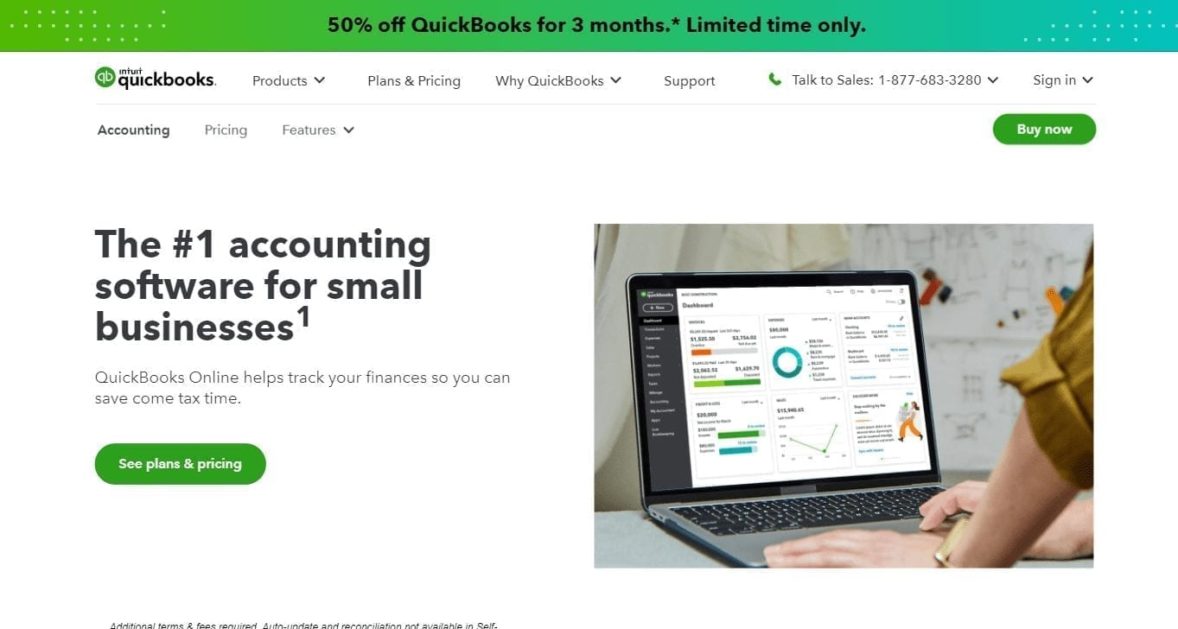
Accounting software paints a clear picture of your business finances. Most software companies offer charts and graphs as part of their reporting. Plus, they’ll provide more information about your consumer’s habits and spending.
These reports can help you better understand your customers and make any adjustments accordingly, like if and when you run sales.
These accounting software tools also integrate directly with your site. This integration, plus the lack of human error, can result in more accurate bookkeeping and financial reporting.
Step 6: Order Products & Outline Your Fulfillment Strategy
Even if you’re handmaking your products, you’ll still need to order some items from a manufacturer when starting an online boutique. Without them, it’ll be difficult to scale your business online.
If absolutely 100% of everything is handmade, you’ll be working nonstop. You might make your own earrings, but having some manufacturers send you supplies for the earrings can help.
Find a Supplier
In your hunt for a supplier, ensure they offer everything you may need for your business online. Having a manufacturer that can act as a one-stop shop for your business can save you time and money in the long run.
Price Your Orders
If you aren’t sure how to price your orders, remember that you need to make sure all of your costs are included.
This means if you’re offering free shipping, you want to make sure your profit margin is high enough that you’ll still be able to cover it without losing money at the end of the day.
An easy way to price your products is to add up your total costs and then factor in your profit margin. If you find that you’re not selling at that price, you can always try offering sales to see how low you need to go before the customer hits buy.
Sales can also add an allure of a limited-time deal, so use these as an opportunity to gather some data about your customer’s buying habits.
Plan How You’ll Fulfill Orders
Order fulfillment plays a huge role in customer satisfaction. Before you sell anything, you’ll want to make sure you have order fulfillment planned out so you don’t feel like you’re scrambling after making sales.
People expect order fulfillment to be quick, from the checkout process, customer service inquiries to shipping times. Services like ShipBob make it easy for you to outsource your fulfillment and streamline the process.
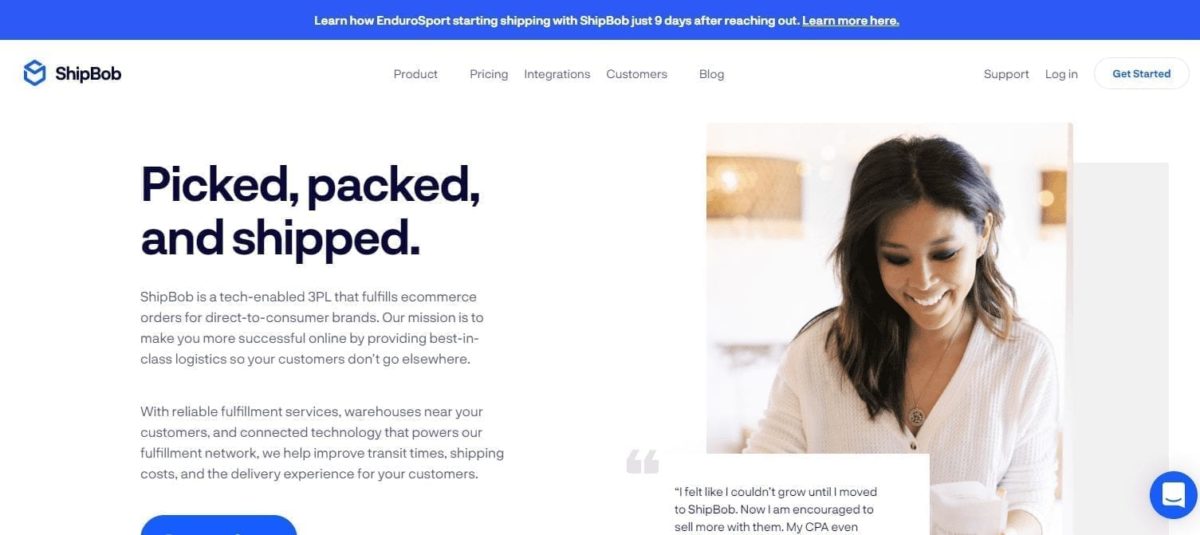
Ecommerce fulfillment services offer a variety of features in the order processing pipeline. They also offer discounts on shipping services so you don’t have to pay top dollar for fast or international shipping. If you want to ship your products yourself, you can use shipping software.
The best one for your online clothing boutique will depend on where you’re selling, how much you’re selling, and what type of ecommerce business model you’re using.
Step 7: Attract Customers to Start Selling
Once your shop is set up, it’s time to start drawing in customers. While setting up your ecommerce store with search engine optimization practices is always a good idea, SEO is a long game. Here are some things you can do to start attracting customers right away.
Write stellar product descriptions to increase sales
Did you know that 87% of consumers say that product descriptions are either important or extremely important in their buying decision? Making sure you have effective product descriptions can make or break your sales.
If you want to write effective product descriptions to boost searchability and sales, be sure to answer any questions your potential customers might have. You want to include not only what your product is, but what problems it solves, how it solves the problems, and why it’s better than the competition. Using persuasive language in your marketing copy can also give you a boost, too.
Why you should create an email list
Social media is great, but you don’t actually own it. If Facebook or Instagram go down (which they often do!), then you’ll be without a way to communicate with your customers.
Enter email marketing. Email lists are a great way to stay in touch with your fanbase, keep them engaged, and offer coupons to keep them coming back for more. Plus, you actually own your email list – unlike your follower list on a social media platform.
Marketing automation software makes this easy. You can set up emails to automatically send out whenever someone buys something to thank them, offer coupons on their next purchase, and share new product launches.
Start sharing on social media to grow your following
Sharing social media posts is a great way to start building your following. This is especially true for Facebook, Instagram, and TikTok when it comes to online boutiques. You can also use your social media posts for paid advertising.
Many online boutiques see success by sharing TikToks and Instagram Reels highlighting their small businesses. If you share videos, you don’t need anything fancy. Something filmed on your cell phone to highlight your products set over some trending audios can go a long way.
CoquetteKouture, for example, regularly gets over one million views on their TikTok videos. They share ways to style their clothing and behind-the-scenes snippets of how they make their clothes.
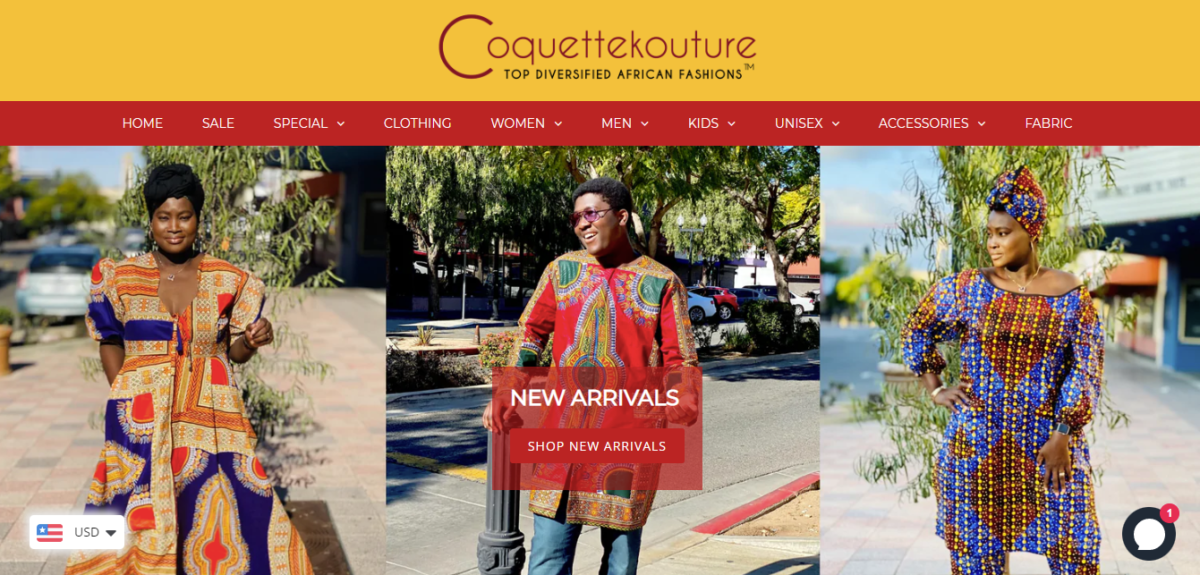
If you aren’t ready to start filming, you can still share beautiful photos on Facebook and Instagram to promote your business online. Plus, both Facebook and Instagram have in-platform shopping features. This helps new customers shop directly within the app. Setting up a catalog for Facebook and Instagram can help you boost sales.
And remember – people like to connect with other people, not brands. Remember to humanize your boutique by making some of your posts inspirational, educational, or entertaining. A strong social media marketing strategy can really help you make sales.
Partner with influencers to expand your reach
Partnering with fashion influencers can really get your brand on the map. Influencer marketing is expected to reach $13.8 billion by the end of the year, and 90% of survey respondents said they found it to be effective.
Influencers have a history of trust with their highly engaged audiences, so by sharing your products with influencers, you can expand your audience through their endorsements.
Partnering with influencers also helps you to get your product in front of your ideal audience. If you select the right influencers who share posts that fit your brand’s look and feel, plus have a high engagement rate, then you’ll see a higher ROI on influencer marketing.
Create an affiliate marketing program
Many online stores and boutiques tap into affiliate marketing to grow brand awareness and sales. Affiliates will have their own unique link and/or discount code that they can share with their friends, family, and followers when promoting your products.
If they make a sale with that link or coupon code, then they can get a commission off of the sale – typically between 5 to 15 percent, depending on the average price of your products.
Affiliate marketing in the United States is expected to grow to $8.2 billion by 2022. And since the start-up and ongoing costs of using affiliates are low, it’s a great way to market your products.
Ask for consumer reviews to build trust with prospective new customers
Having reviews on your products can help you build consumer trust. Sending an email to customers to encourage them to leave reviews can be a great way to generate more. You can send these emails after they make a purchase using the specified payment method. You can also incentivize them by offering coupons or discounts after leaving reviews.
Is an Online Boutique Right For You?
Creating a new online boutique may feel overwhelming, but if your business structure is solid before you even launch, then you’ll feel all the more at ease once you are ready to make sales.
There may be a lot of startup costs, from website costs to fulfillment and shipping costs, but an online boutique website can be an extremely profitable business. This is especially true if your digital marketing is on point and you are passionate about what you are selling.
Boutique owners have plenty of options to start their own website and sell clothing online. Take your time researching all of the available options so you can be confident come launch day.
Most ecommerce platforms support various payment gateways, each with its own advantages and disadvantages. Going through reviews can help you determine which special features and platforms will work for you so you can have a successful business.


